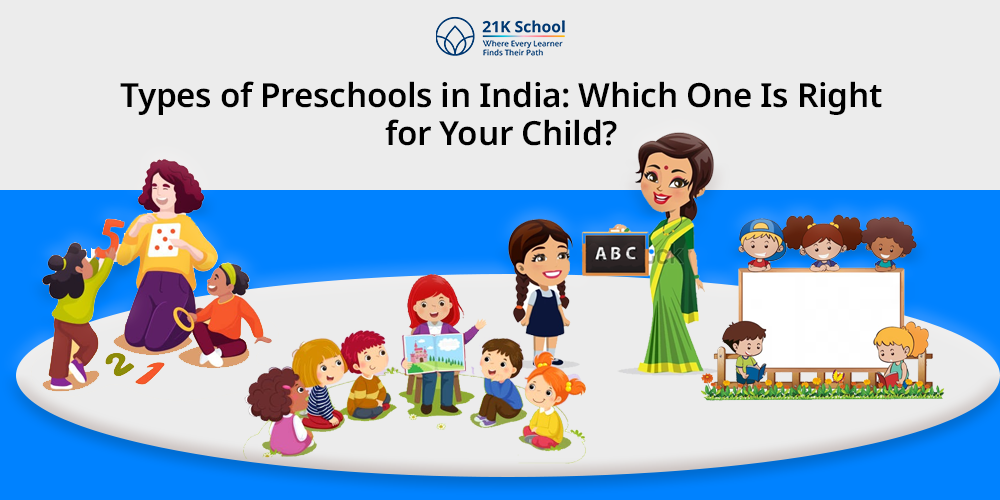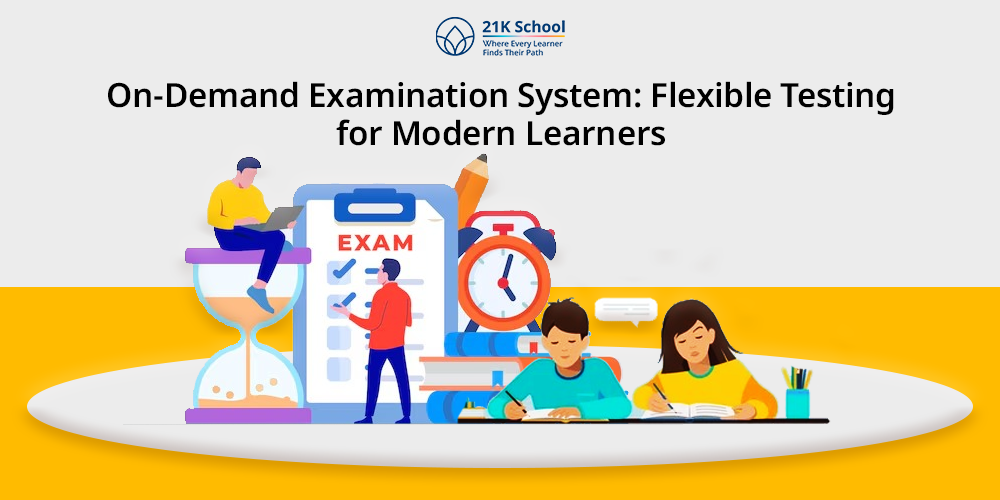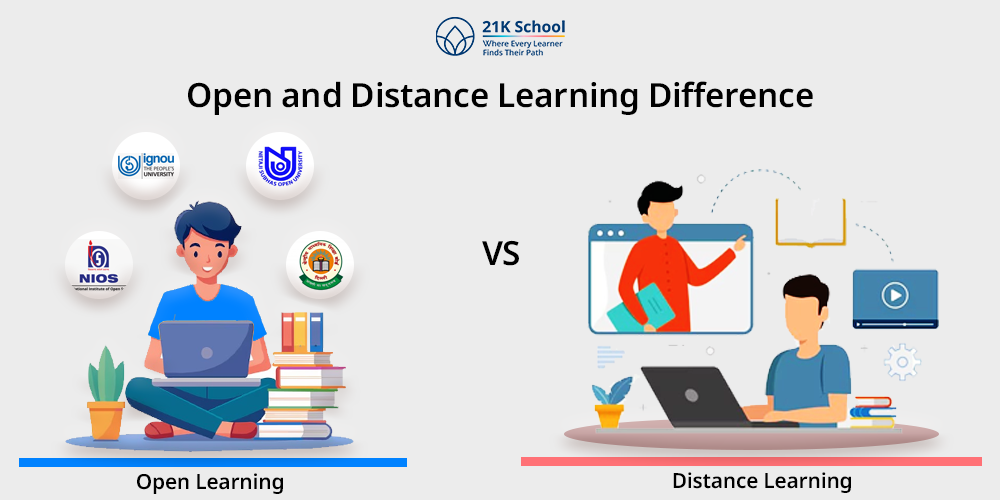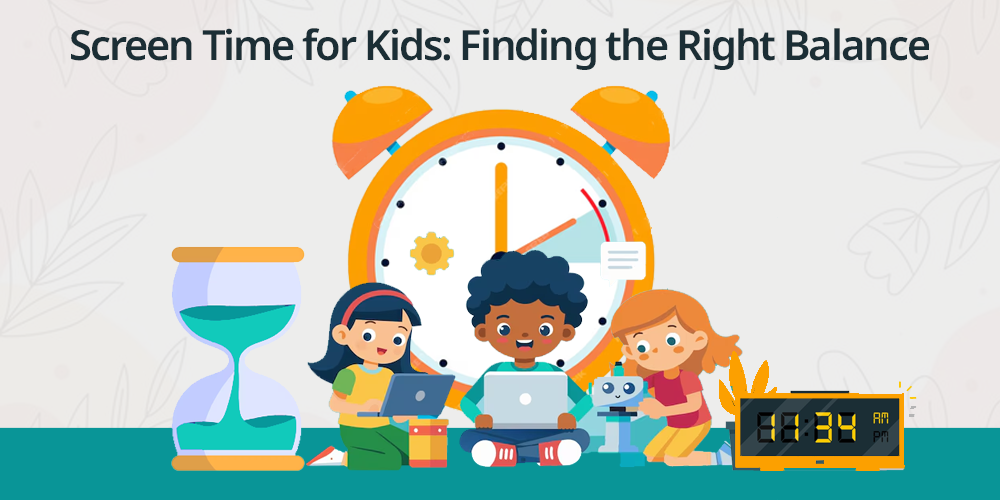
The world is text savvy and screens are everywhere.
Whether it be tablets, smartphones, TV’s, laptops or gaming consoles we are digitally connected and screens are right across our face at every time.
As parents and Caregivers, we are often struggling to dedicate this balance between the screen time that the digital world has to offer and the entertainment that the real world has.
It is a struggle to navigate our ways to keep our kids engaged for a longer period of time without using screens.
So the real question is how to manage it ?
What is the first step towards the screen issue ?
And what exactly is…. Screen Time?
Screen time is referred to the amount of time that a person has spent using a device with a screen.
It can be for any purpose : educational, entertainment or social interaction.
For kids it has to attend virtual classes and in some cases it is provided to always play games or watch cartoons.
As parents we believe that these technology advancements are there to make a parenting journey easy but it is a myth!
The screen can be a fantastic resource for learning and entertainment but it is important to understand that not having screen time is beneficial for students.
The content being displayed on screen plays a very important role in determining a kid’s development, and we cannot say that it is just beneficial to them, rather it is harmful to a level that can harm them physically mentally and emotionally.
Contents
Recommended Screen Time Guidelines by Age
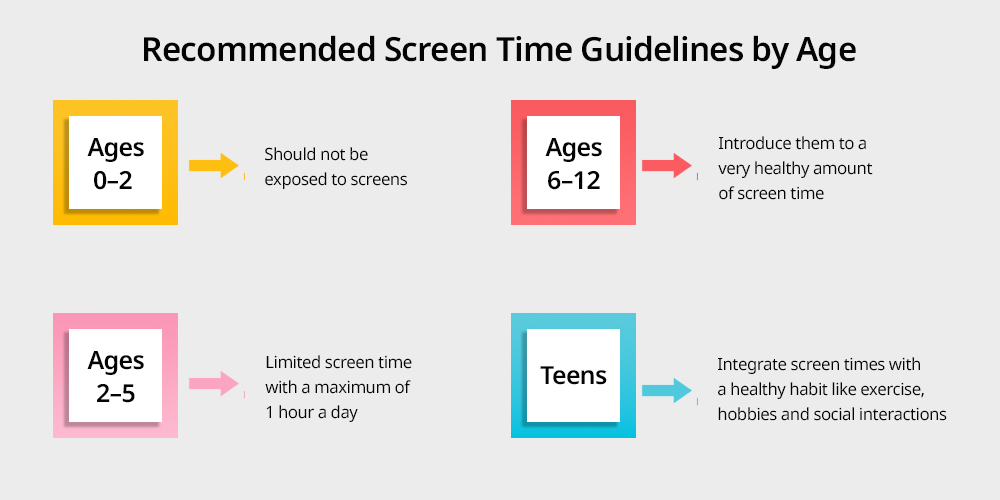
There is a well structured screen time guideline provided by organisations like World health organisation (WHO) and American academy of pediatrics (AAP) which helps parents in understanding the uses of technology and provides valuable guidelines for managing screen times for students based on age.
- Ages 0–2:
Children from the age group of 0 to 2 that they should not be exposed to screens and it should be avoided for them from a closer view.
And in case they are to be introduced they should not be engaged in any other activities except for video calls with family and friends.
There is a scientific reason that backs up this point of view as at this stage a baby’s brain is rapidly developing and requires face to face interaction to understand the environment and learn from human behaviour.
- Ages 2–5:
Children from the age group of 2 to 5 should have a limited screen time with a maximum of 1 hour a day where the main focus for parents should be on high quality and age appropriate content.
It is suggested for parents to show kids content and applications that are designed especially for them for learning purposes.
The shows and applications designed for kids of this age group are to support the development.
Also it is suggested that caregivers should have a direct interaction with their kids as their first priority rather than introducing them to any technological devices as it can be addictive.
- Ages 6–12:
For the students of the age group of 6 to 12 are suggested to introduce them to a very healthy amount of screen time while they balance between physical activities and offline learning also.
Students at this age might use screens for school work and some other extra activity to distract themselves from the monotony of life.
Although the digital screen may look appealing to kids of this age and it might get addictive therefore it is very important for parents to set boundaries regarding the screen time in order to prevent the over use.
For parents it is very important to understand that direct interaction and human connection is very important and students need to go out and participate in social activities to grow in all aspects of life.
- Teens:
For kids who are above 12 and are in their teenage years, distracting them from mobile phones and other technological devices is a difficult task.
Parents have to understand that moderation is the key, and every moment a student or a kid pens on a mobile phone should be highly moderator and observed as it is a very tender age and there are high chances of being influenced by unrealistic standards of society set on social media.
Parents have to encourage teams to integrate screen times with a healthy habit like exercise, hobbies and social interactions well embedded in their everyday routine to ensure that they are socially active at all times.
Parents have to take initiative to have open conversations with kids about digital boundaries and online safety as the digital world is very fragile and can negatively influence kids at this age.
Here’s a list of different activities for kids without screen time.
The Impact of Excessive Screen Time
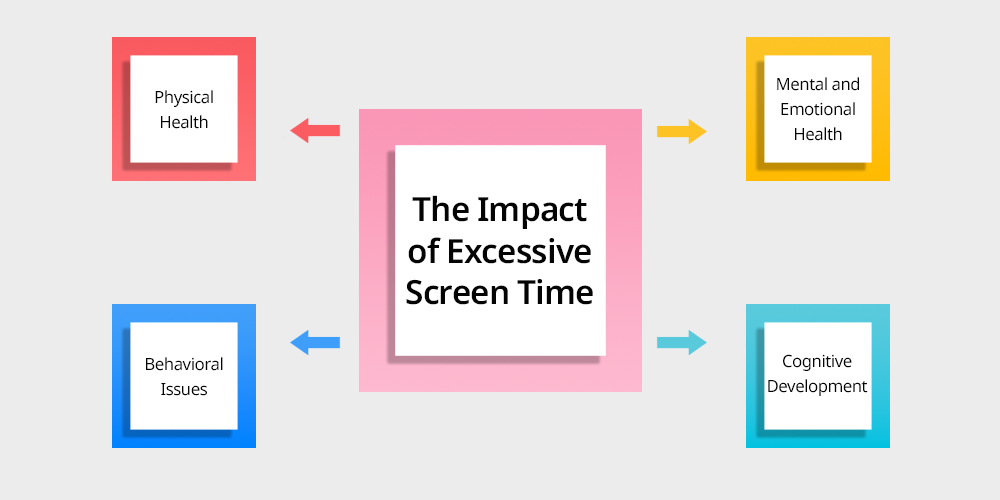
There are very great impacts of excessive screen time on students especially in the cases when screen time is not managed well it can lead to a range of negative effects on children on all aspects of health whether it be physical, mental or cognitive.
Further ahead we will be dealing with all the aspects individually in detail :
1. Physical Health:
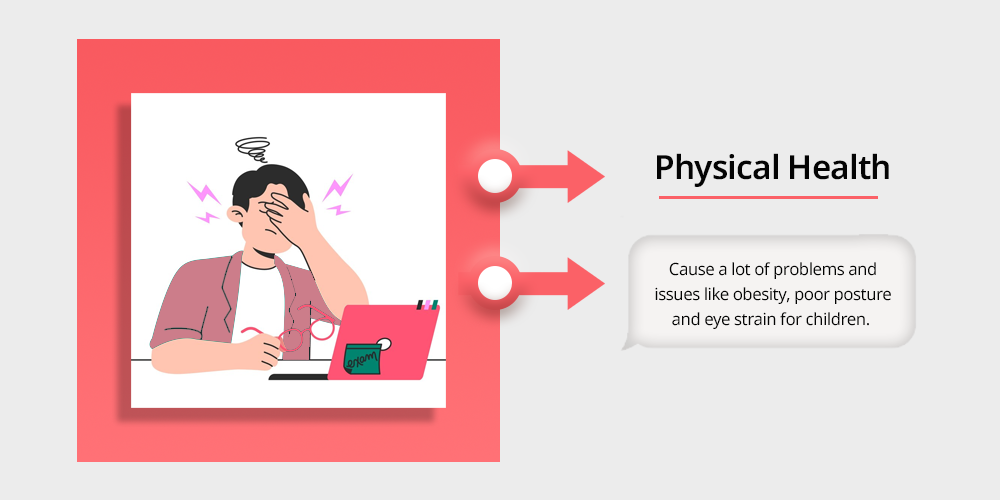
When a child spends more time in front of the screen they tend to get addicted to it and it becomes a cycle where they prefer sitting in front of screens for longer hours.
Spending long hours in front of screens can contribute to a sedentary lifestyle which can cause a lot of problems and issues like obesity, poor posture and eye strain for children.
Because of these issues a child can have problems like indigestion and cervical problems and can even lead to poor eyesight where the child will have to use spectacles at a very early age, due to excessive exposure to blue light.
Exposure to screen before bedtime can disrupt their sleep pattern making kids more irritable and tired the next day which can lead to behaviour issues in them.
2. Mental and Emotional Health:
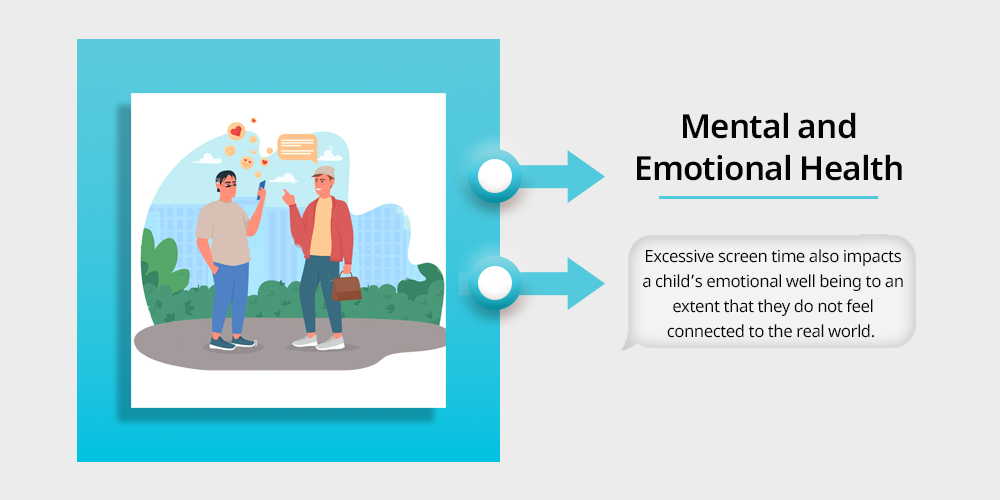
Excessive screen time also impacts a child’s emotional well being to an extent that they do not feel connected to the real world.
Studies have suggested a very valid link between prolong screen use and increased risk of anxiety in kids where in case the problem sustains for a longer time it can lead to depression and suicidal thoughts due to lower self esteem.
Certainly these situations occur as social media sets and unrealistic standards of life which in particular create a feeling of inadequacy or a fear of missing out (FOMO).
3. Cognitive Development:

Kids who are exposed to technology devices from a very early age often have a slow or cognitive development in themselves where it is believed that a child’s brain is like a sponge and it absorbs everything around.
The phone screens are said to have bright colours, high frequency lights and addictive sounds for kids to keep them engaged, which make the real world feel more dull to children in such cases they do not feel connected to the world and they prefer looking into the phone screens more.
Due to excessive screen Times and low quality content which is not supervised by the parents and caretakers it can hinder a child’s problem solving skills and attention span which will ultimately restrict their creativity and also limits their opportunity for critical thinking and hands-on exploration in life ahead.
It is not just a temporary problem in case this problem exists and goes along for a longer time. It can have prolonged effects on a child and can restrict their mental growth, making them vulnerable to these phone screens.
4. Behavioral Issues:

Mobile phone screens are often accompanied by tantrums and mood swings in children where over exposure to the screen becomes addictive and kids do not like “NO” particularly.
In cases where a child is addictive and parents are restricting their activity it becomes difficult to manage emotions which leads to decreased patients and unnecessary tantrums and more things in children.
Kids who heavily rely on the screen for entertainment often struggle in the real world.
The real world doesn’t seem that entertaining and engaging to them due to dull colours and natural voices rather than high frequency sounds and vibrant colours which later makes them struggle with boredom and frustrations when they are not engaging with any device.
The situation can be very harmful if not managed on time.
there are some unique things to ensure that your students stay creatively-engaged, especially without screens.
Benefits of Moderate and Well-Managed Screen Time
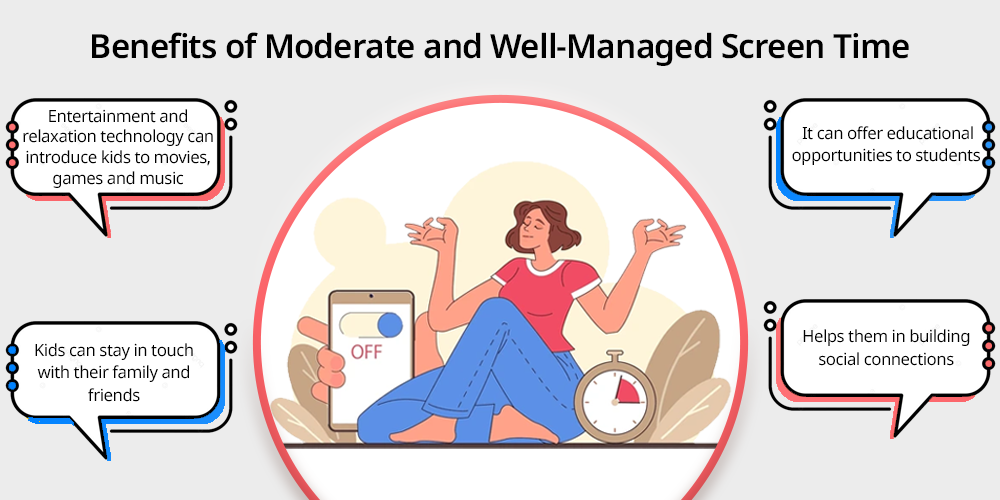
There are multiple benefits to moderating and managing a child screen time where when handled thoughtfully it can offer multiple benefits to parents and the student.
Firstly it can offer educational opportunities to students where they are provided with high quality apps and programs which can introduce kids to new concepts and enhance their literacy level by teaching them some of the basic subjects like maths and coding in a fun way with the help of technology.
Technology also helps them in building social connections where they will manage screen times, video calls and appropriate use of social media applications.
Moderate technology ensures real education with real time involvement.
Kids can stay in touch with their family and friends building meaningful relationships and connections which will help them grow socially. Giving new dimensions of Social learning, promoting several benefits to social learning.
When it comes to entertainment and relaxation technology can introduce kids to movies, games and music which will provide an easy escape from the monotony of life and help them in relaxing with a healthy dose of fun which is also very essential to childhood.
Well managed and highly moderated Screen timings can also help children in skill building where kids have options to explore different platforms that encourage creativity, problem solving and critical thinking through interactive games and activities provided on the platform.
Tips for Managing Screen Time
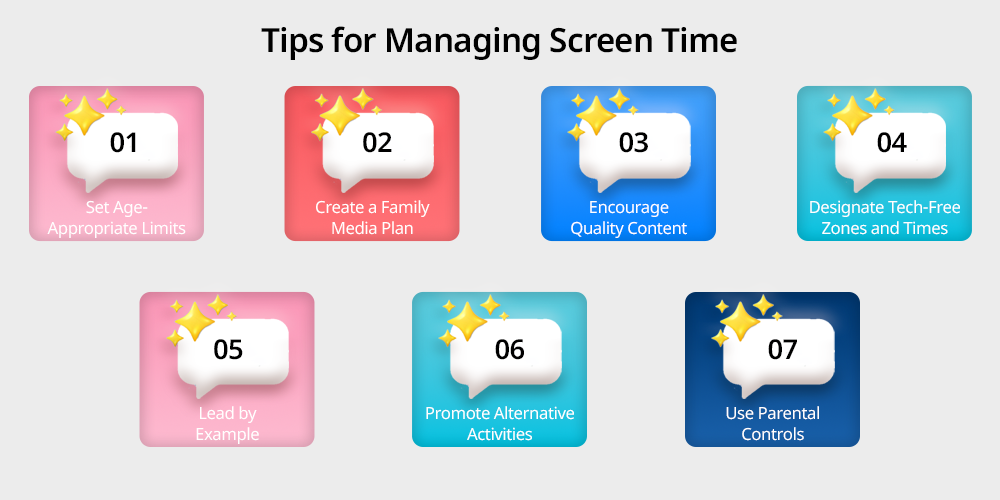
Finding the balance between screen time and offline activities can be overwhelming for parents and it does not have to be a battle.
Screen time can be managed well with certain tips that are practical and strategy that can help parents in managing screen time for the kids effectively:
1. Set Age-Appropriate Limits:

It is suggested for parents to tailor screen time rules for their children as per their age and their needs.
Consider an example where the younger child has to have a strict time limit then the older kid, as an old kid can take more responsibility with clear guidance in place.
Exceptions can be in a situation where the children are being involved in online classes and online learning, although that also needs to be managed effectively with proper rest and eye exercises to support their balance.
2. Create a Family Media Plan:
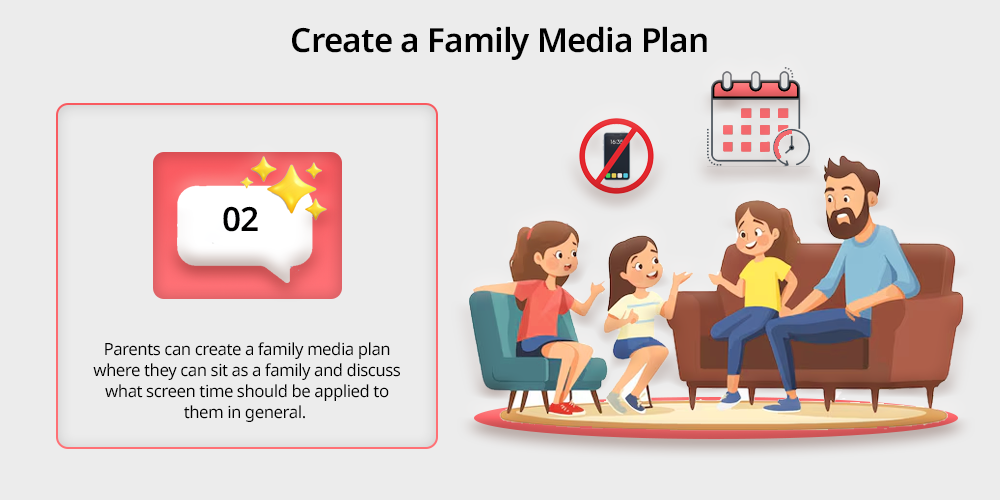
Parents can create a family media plan where they can sit as a family and discuss what screen time should be applied to them in general.
It is to decide on rules like no screen times during meals or homework time where it can later become a habit and kids will start sticking to it consistently.
And rules are for everyone in this media plan; nobody has any exceptions.
3. Encourage Quality Content:
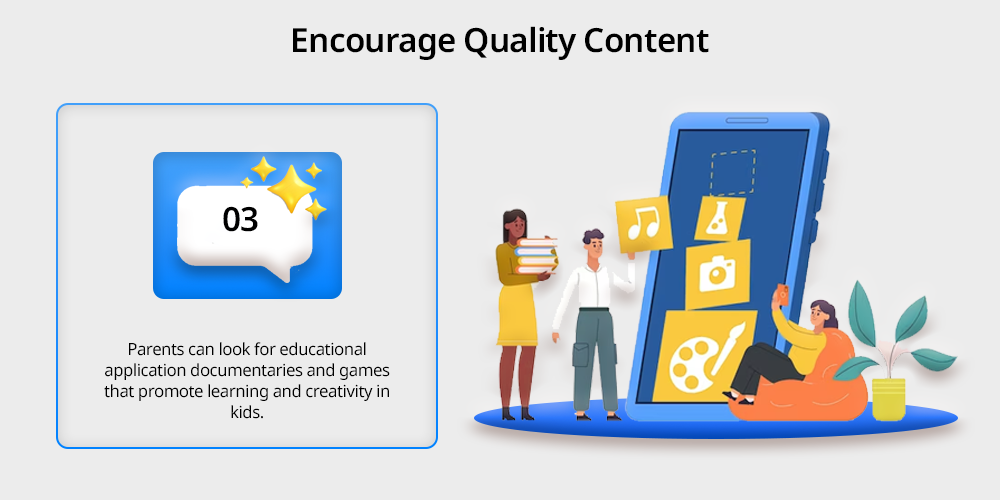
Parents can encourage quality content not all screen times are bad there are certain activities that can be promoted for the limited time.
Parents can look for educational application documentaries and games that promote learning and creativity in kids.
It is also suggested for parents to consider co-viewing a program with those children so that it can provide opportunities for children to build and grow a bond and have open discussions.
4. Designate Tech-Free Zones and Times:
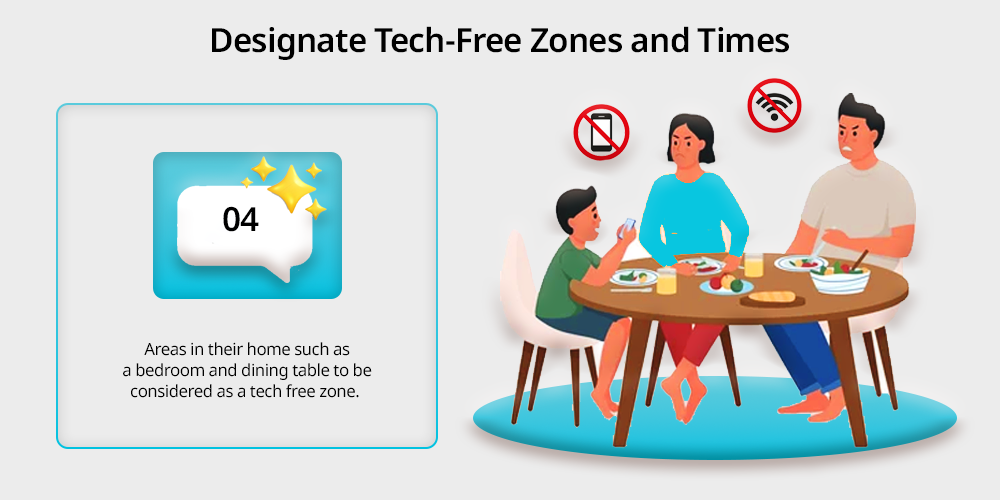
Parents can designate an area as a tech free zone or a tech free time in their household where they can certainly mark areas in their home such as a bedroom and dining table to be considered as a tech free zone.
This can be implemented in a case where the child has to pursue online education so that they do not step out of their work area with the same level of screen.
Parents can establish tech free time during meals or before bedtime and even in a situation where family is going for an outing to encourage real world interaction and connection building.
5. Lead by Example:
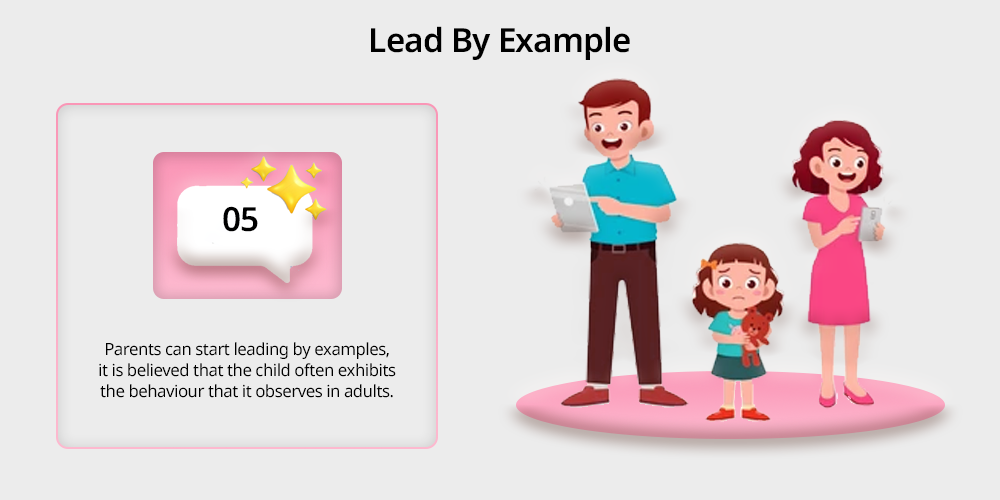
Parents can start leading by examples, it is believed that the child often exhibits the behaviour that it observes in adults.
As they mirror the adult behaviour it is suggested for parents to adapt themselves to our healthy screen habit themselves so that the child learns from them.
They can start by putting their phone away during family time and show them that there is a life outside the screen that can be equally engaging and interactive.
It is very similar to a situation where it is believed that a child learns from what it sees at their home : home is a child’s first school.
6. Promote Alternative Activities:
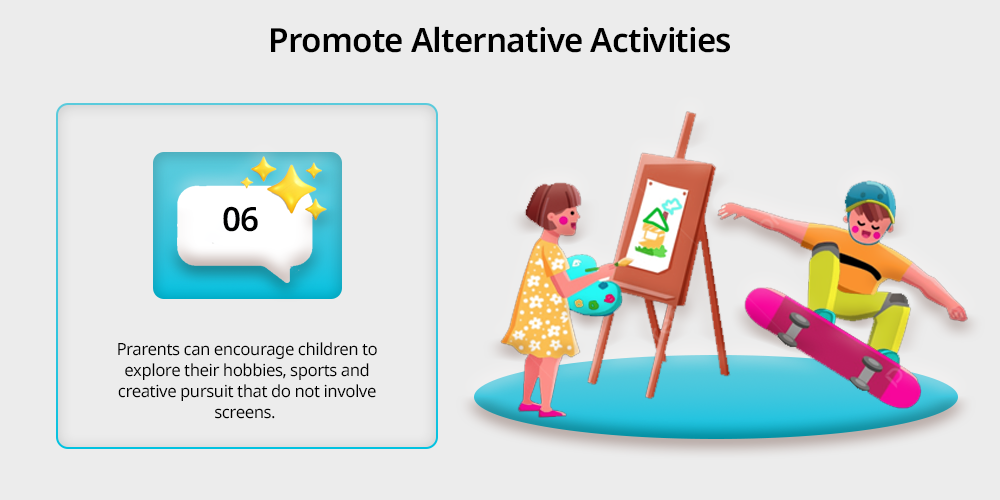
Parents and why promote alternative activities for their children where they can encourage children to explore their hobbies, sports and creative pursuit that do not involve screens.
Parents can introduce their children to activities like : reading, drawing, cycling and playing board games.
These are some of the best alternatives that can be engaging to a child and can also contribute to several skill development in them.
7. Use Parental Controls:
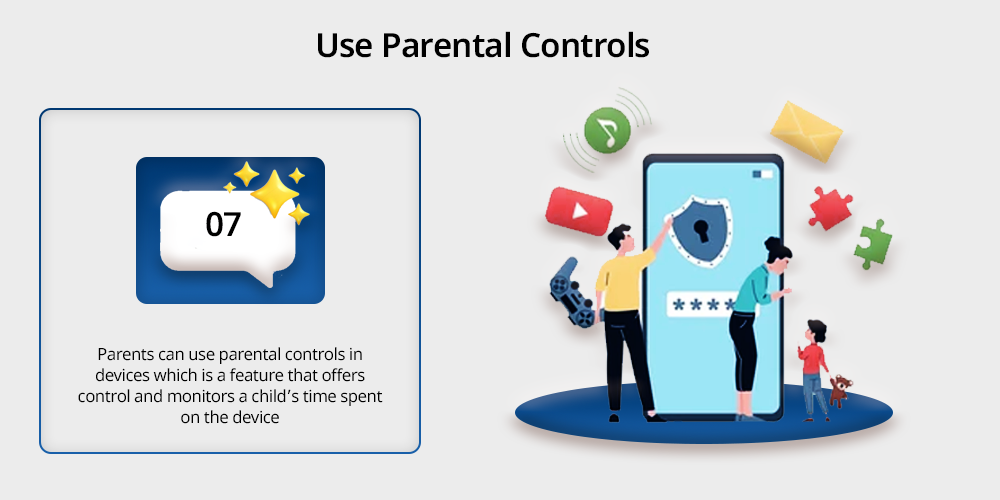
Parents can use parental controls in devices which is a feature that offers control and monitors a child’s time spent on the device and it also limits the screen time as per the requirement.
They can use tools to set boundaries and block all the inappropriate content for their kids ensuring that they are providing their kids a safe online environment.
Conclusion
Screen time is not evil, rather it is important to strike a balance.
With the right balance parents can achieve a lot of advancements and benefits from screen time for their kids.
By setting boundaries and encouraging high quality content parents can help children in enjoying the benefits of technology without falling into any pitfalls and they can also promote offline activities along with it.
Read this blog on : How Technology Can Support Student’s Success
This will help them in ensuring that there is a life beyond the screen and it is equally engaging and interactive.
Remember for parents the goal is not to eliminate the screen but rather to serve it as a tool for kids to ensure learning, connection and growth in them.

